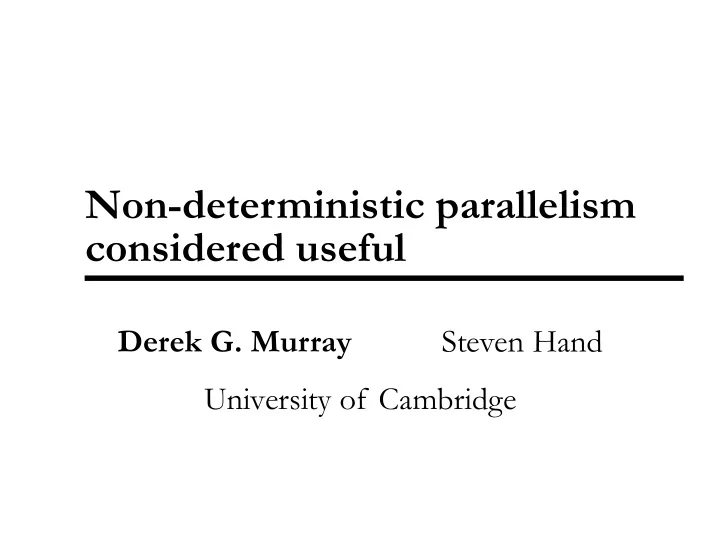

Non-deterministic parallelism considered useful Derek G. Murray Steven Hand University of Cambridge
1. Parallelization 2. Synchronization 3. Scheduling 4. Load balancing 5. Communication 6. Fault tolerance 7. Guaranteed termination
1. Parallelization 2. Synchronization 3. Scheduling 4. Load balancing while ¡ (x) ¡{ ¡ 5. Communication ¡ ¡ ¡ ¡… ¡ } ¡ 6. Fault tolerance 7. Guaranteed termination
1. Parallelization 2. Synchronization 3. Scheduling 4. Load balancing 5. Communication 6. Fault tolerance ⇔ Deterministic 7. Guaranteed termination
Real programmers don’t use deterministic parallelism
Real programmers use • Async. Networks • Timeouts • Real hardware • Signals • Performance • select() loops interference • Condition variables • User input • Mutable state All of these cause non-determinism!
Example: branch-and-bound J K L M
Deterministic data flow J K L M T
Irregular parallelism J K L M
Irregular parallelism J K L M T
Non-deterministic select J K L M SELECT T
Non-deterministic select J K L M T
Non-deterministic select J K L M T
Asynchronous signals work stealing/ shedding J K L M new bounds
Asynchronous signals J K L M
Asynchronous signals J K L M
1. Parallelization 2. Synchronization 3. Scheduling 4. Load balancing 5. Communication 6. Fault tolerance 7. Guaranteed termination
1. Parallelization 2. Synchronization 3. Scheduling 4. Load balancing 5. Communication 6. Fault tolerance 7. Guaranteed termination
Challenge: dealing with faults • Fail everything • Error codes/exceptions • Bounded non-determinism • Checkpoints • Record and replay
Conclusions • Many benefits of non-determinism – Performance, adaptability, interactivity • System must allow non-determinism • Determinism at language-level – For programmers who need training wheels
Recommend
More recommend